be quiet! Dark Rock Pro 5 CPU Cooler Review
Best known for black anodized brushed aluminum accents, be quiet! might have faced a crisis last spring when one of its rivals decided to ape the aesthetic features of its big air coolers. That be quiet! thinks it can go one better with its Dark Pro 5 is no problem for us: We’re happy to see what the slight smaller, slightly cheaper big air CPU cooler brings in terms of quality, acoustic and thermal performance.
| be quiet! Dark Rock Pro 5 | |
| Type | Cross Draft Dual Tower |
| CPU Support | LGA 1700/1200/115x, AM5/4 |
| Height/Width/Depth | 167mm / 140mm / 146mm |
| Base Height | 44mm |
| Offsets | 26mm forward w/front fan |
| Fan Size | (1) 135mm + (1) 120mm x 25mm |
| Connectors | (1) PWM |
| Weight | 1388 (49oz) w/Intel kit |
| Web Price | $100 |
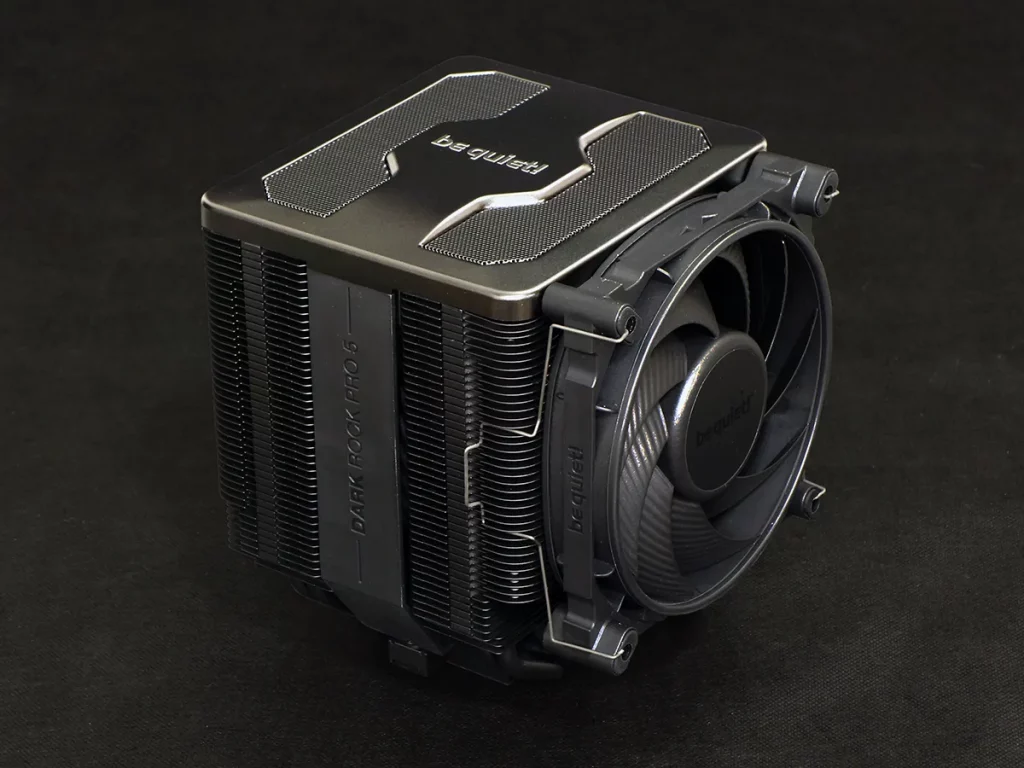
Inside the Dark Rock Pro 5 box are the CPU cooler, instructions, a tube of thermal compound, an Intel style installation kit with LGA 1700 and LGA 115x spacing, an AMD mounting kit with AM5/AM4 spacing, and a long-shaft Phillips #2 screwdriver.
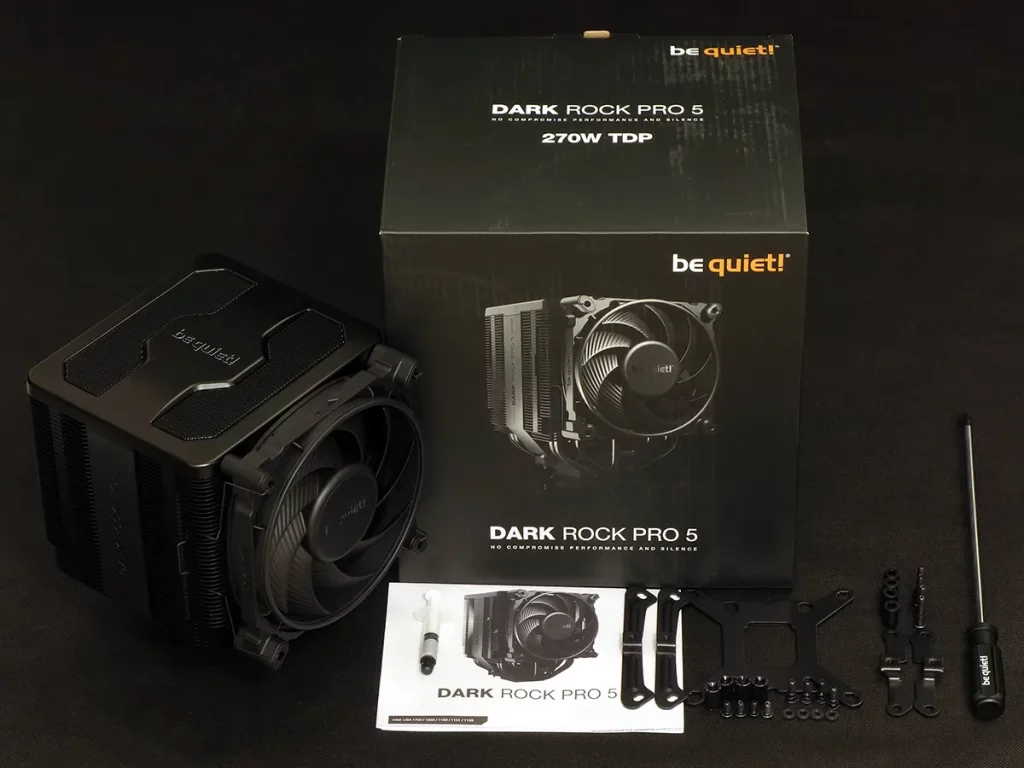
An all-copper base that holds seven heat pumps features a turned finish that’s exceptionally flat and smooth enough to minimize the amount of thermal compound required to mate the heat exchanger with the CPU’s heat spreader. Also notice the unique fan cable: It engages a splitter that’s soldered to the center fan, allowing the two to be separated. The other fan’s power input is standard four-pin PWM.

Like that previously reviewed competing model, Dark Rock Pro 5 features a snap-in center fan bracket that holds a custom 135mm fan on two 120mm-spacing screws on one site and a black-anodized brushed aluminum cover on the other side. The biggest difference in the be quiet! design is that both the pins and the sockets that make up these snaps are molded plastic, whereas the MA824’s lid features a rolled edge with snap holes drilled into the underside of that edge: The MA824’s rough holes chewed up its snap pins during shipping to the point that these were almost unusable by the time our sample arrived. The be quite! design works much better.
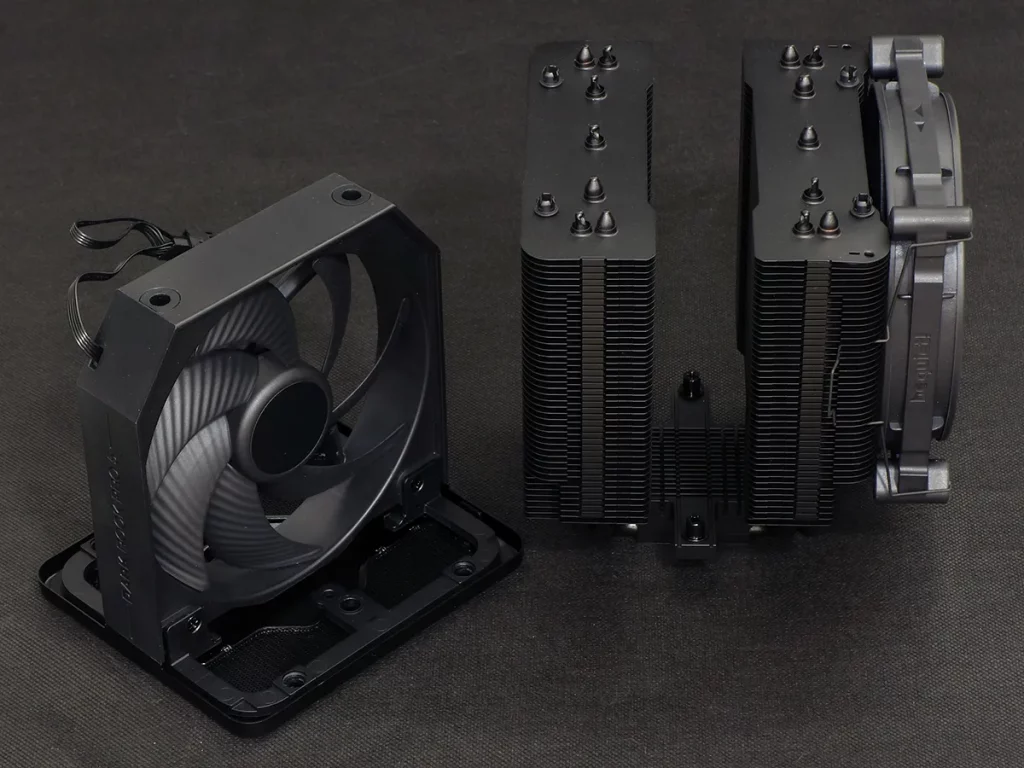
The frame of the Dark Rock Pro 5’s lid is attached with magnets, so that it can be easily removed and spun 180° to keep the logo upright on upside-down systems. Of course that’s not the only reason fot the removable lid: be quiet! also placed a hidden speed control switch here. Switching it from performance to quiet mode drops the front fan from around 2000 to around 1500 RPM, and the middle fan from around 1700 to around 1300 RPM.
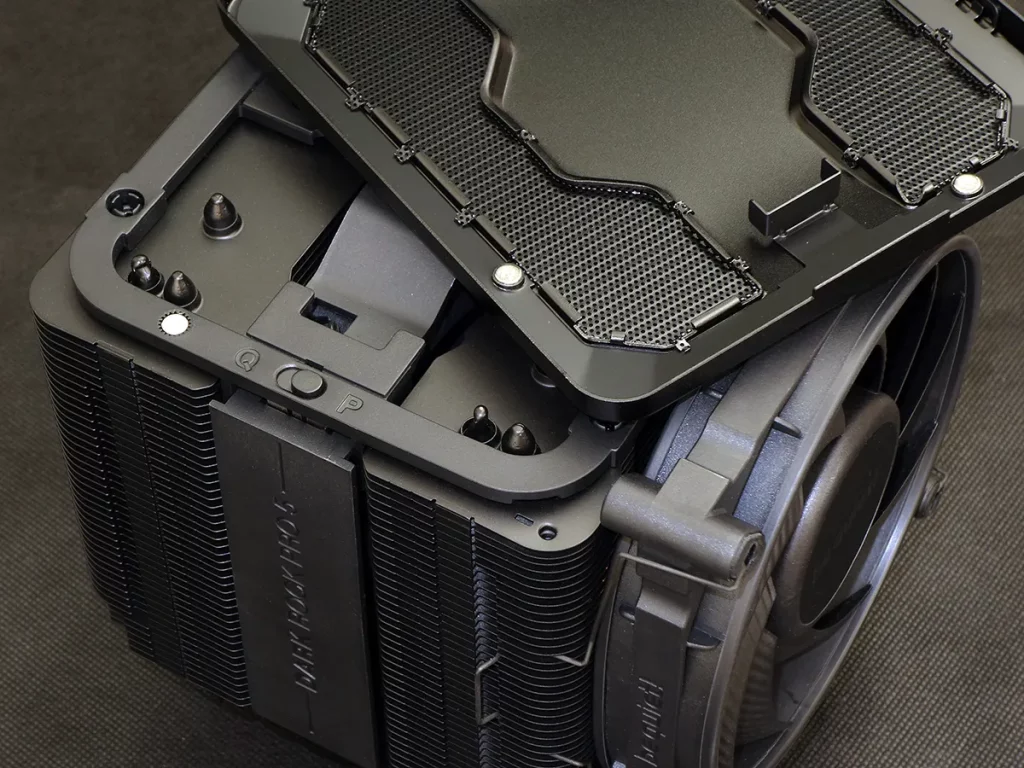
AMD’s AM4 and AM5 motherboards come with clip brackets that are secured to the motherboard by a screwed-on back plate, and the be quite! Installation kit takes advantage of that back plates screw threads to install its own brackets via an includes set of screws and spacers. Intel installations differ slightly in that they require the addition of the Dark Pro 5’s Intel-socket support plate, behind the motherboard.
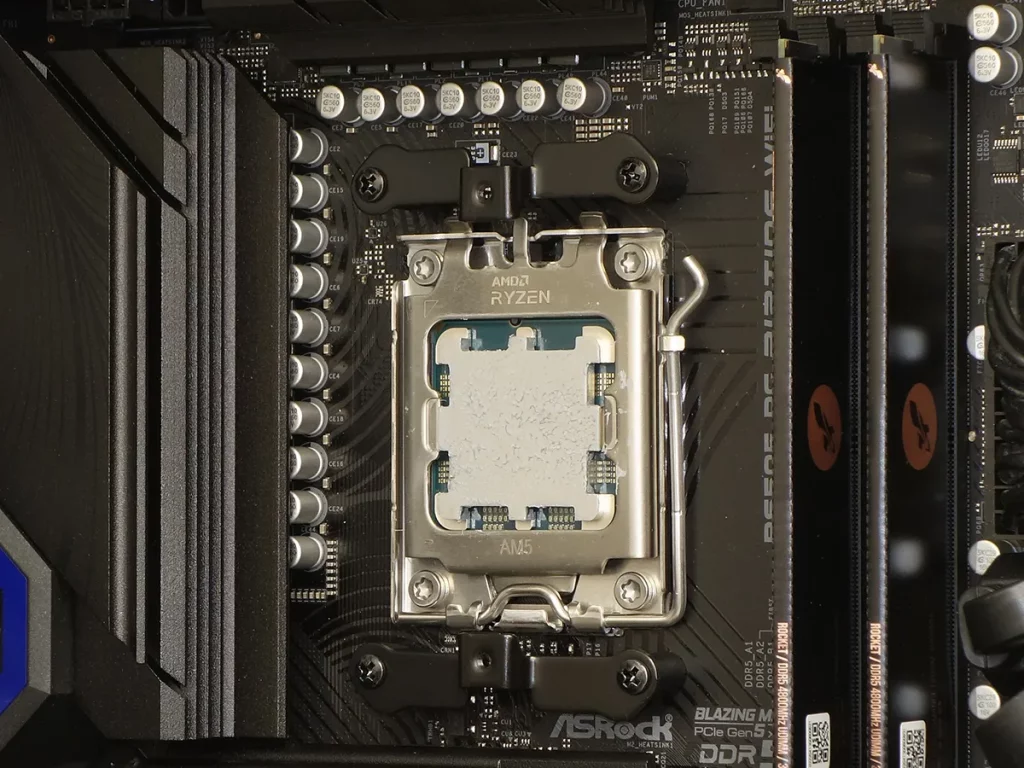
Captured screws attach the Dark Rock Pro 5 heatsink to the above-mentioned cross brackets, and now everyone knows why be quiet! included that long-shaft screwdriver.
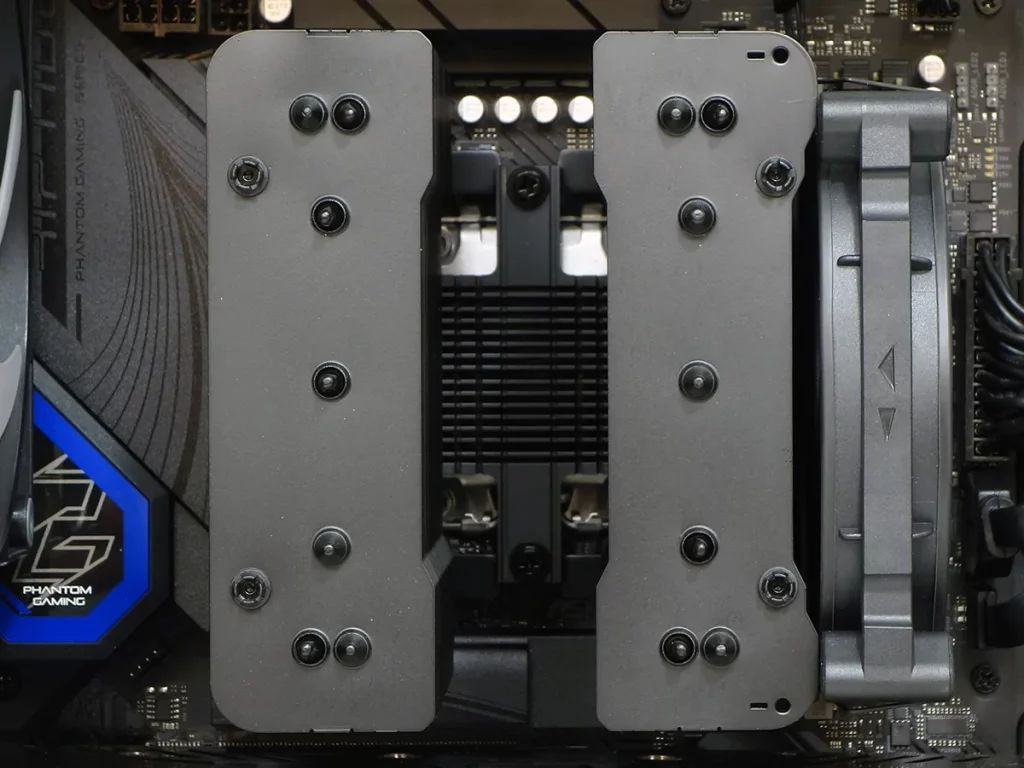
Snapping the center fan bracket back into place, plugging the front fan into the corresponding connector at the middle of the center fan’s cable, and connecting the center fan cable’s end to a motherboard fan header completes installation. We used the motherboard header that’s visible above the front fan in the photo below.

Raising the fan to clear taller modules is as easy as unclipping it from the sides of the sink and sliding it away from the motherboard, as shown in the below promotional photo. This increases clearance from 44mm to as much as 65mm, which is the height where be quiet! switched from short to long heat sink fins. Unfortunately, that does mean adding 120mm (the fan size) to memory module height to determine overall cooler height.

Competing brand Arctic supplied us with two tubes of its MX-4 thermal compound to keep our tests consistent, while an old Thermaltake case sample provides the room we need to test coolers all the way up to 420mm-format liquid cooling systems. That case’s stock front intakes and rear exhaust fans likewise provide big air coolers an optimal test environment.
| System Configuration | |
| Case | Thermaltake Ceres 500 TG ARGB |
| CPU | AMD Ryzen 9 7900X: 12 cores/ 24 threads, 64MB L3 Cache O/C to 5.00 GHz at 1.25 V Core |
| Motherboard | ASRock B650E PG Riptide WiFi, BIOS 1.18 |
| RAM | Sabrent Rocket SB-DR5U-32GX2 64GB DDR5-4800 |
| System Drive | HP SSD FX900 M.2 1TB NVMe SSD |
We haven’t tested many air coolers on the new platform, but treating closed loops in the 240mm format as being in the same size class gives us plenty to compare. Each of the Dark Rock Pro 5’s dual fin stacks is, after all, about half the size of a 120x240mm radiator core.
Test Results
We weren’t surprised to see the formerly reviewed MasterAir falling a little behind a few of its closed-loop liquid cooling rivals, but we are surprised to see the Dark Rock Pro occasionally beating two of those rivals: The ToughLiquid Ultra 240 and Fractal Design Lumen S24 RGB. Lower is better when it comes to temperatures, and we can see that little bit of red poking out in a few places.
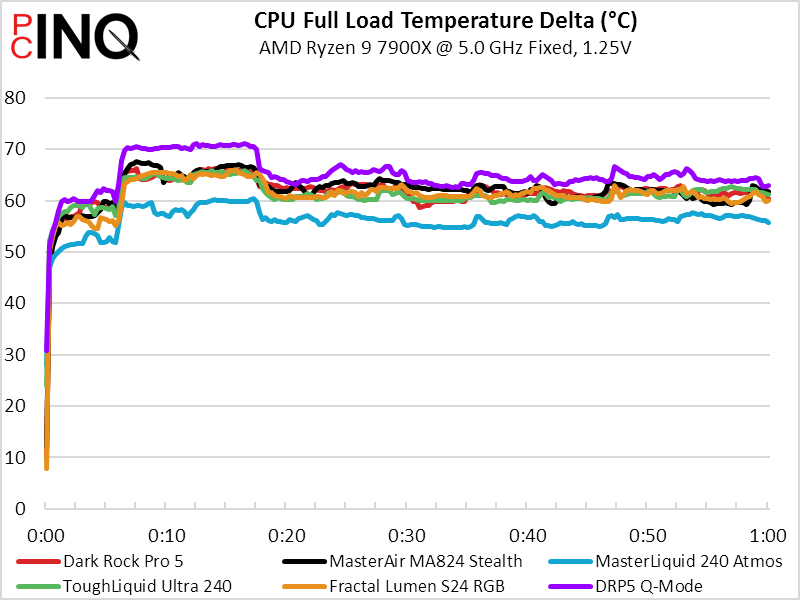
The Dark Rock Pro 5 leads in voltage regulator temperature, and that’s mostly because the fans of heatsink style CPU coolers blow some of their air on the voltage regulator’s heat sinks. We also optimized the closed-loop liquid coolers for lower voltage regulator temperature by placing them directly above the motherboard, but that merely reduced the scale of liquid cooling’s loss.
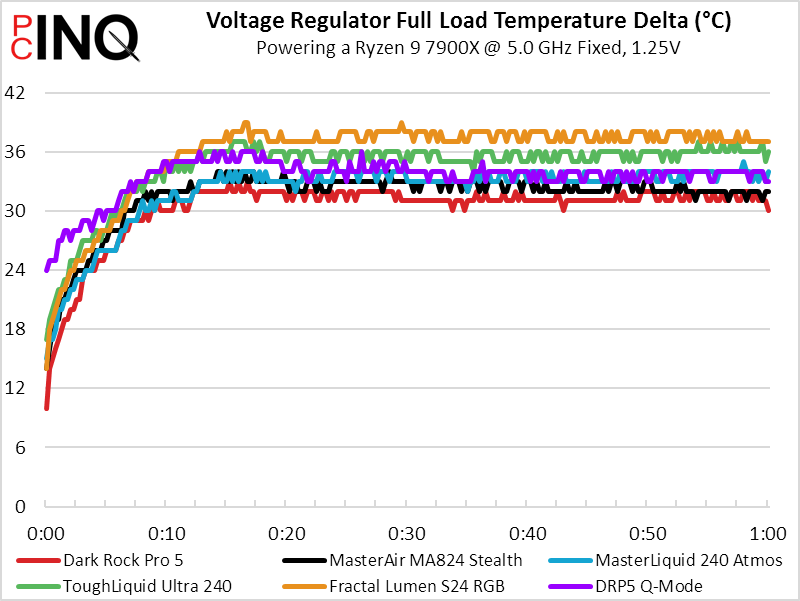
One would hope that the large surface area of liquid cooling radiators would allow companies to choose slower fans to reduce noise, but that would have also increased CPU temperature. Both be quiet! and Cooler Master optimized their heatsink’s fans for low-noise cooling at full speed, and both coolers tested at about 32 decibels (A-weighted).

The air coolers have the best cooling-to-noise ratio due to having the lowest noise levels, despite having temperature deltas that were nine to ten percent warmer than the coolest of the liquid CPU coolers. The Dark Rock Pro 5’s quiet mode dropped it another 3.4 decibels (to 28.6), but we prefer to use motherboard-based fan controls for all of our real-world builds.
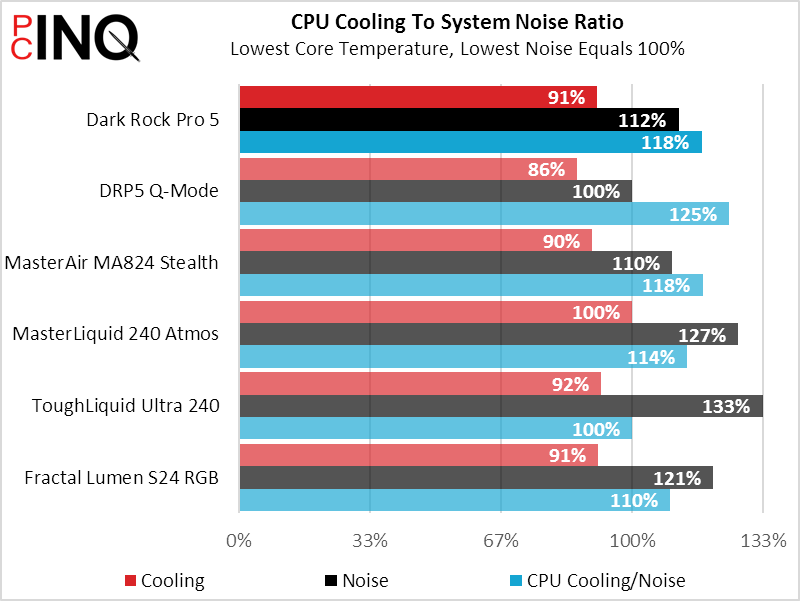
You already knew that having the lowest noise and the lowest voltage regulator temperatures would put the two air coolers in temperature-to-noise lead, but seeing the Dark Rock Pro 5 score 39% above baseline is still a bit startling.
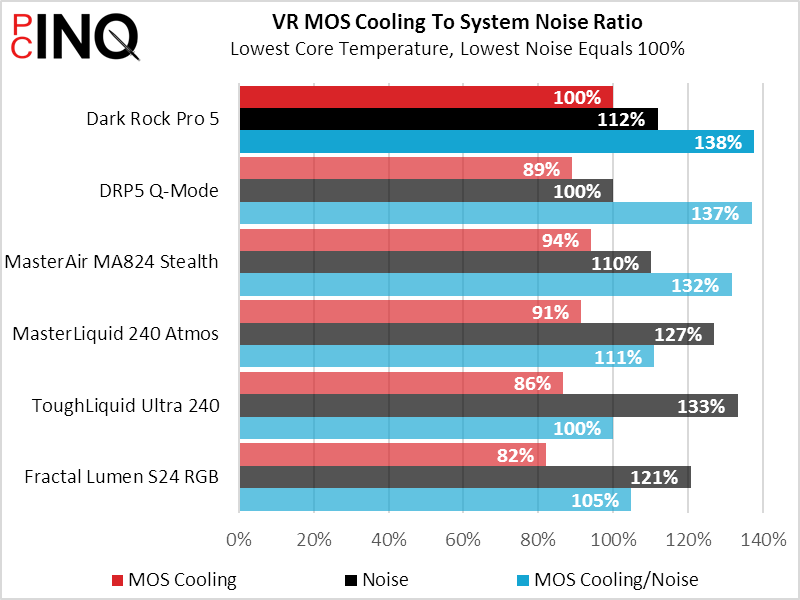
Matching the cooling of some of our lesser 240mm closed-loop liquid CPU coolers while also offering lower noise, the Dark Rock Pro climbs ahead of its big-air rival by being slightly cooler (improved performance), a little smaller (improved fitment), and slightly lighter (less motherboard stress). It wins our approval by doing all of these superior things at a similar noise level and for less money than its closest rival.
| be quiet! Dark Rock Pro 5 (BK036) | |
| Pros: | Cons: |
| Similar cooling to 240mm closed-loop coolers Lower noise than 240mm closed-loop coolers Superior fixing hardware on center fan bracket’s lid Smaller, cheaper, and better performing than MA824 | Big Air coolers may limit DIMM placement Big Air coolers are heavy |
| The Verdict: | |
| The Dark Rock Pro 5 outperforms its closest Big Air rival while also being slightly smaller, lighter, better-built and cheaper. | |


